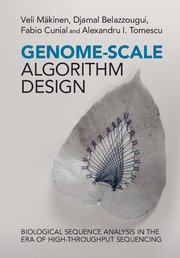9 - Burrows–Wheeler indexes
from Part III - Genome-Scale Index Structures
Published online by Cambridge University Press: 05 May 2015
Summary
Consider the largest sequenced genome to date, the approximately 25.5 · 109 basepair-long genome of the white spruce Picea glauca. The suffix array of this genome would take approximately 1630 · 109 bits of space, or approximately 204 gigabytes, if we represent it with 64-bit integers, and it would take approximately 110 gigabytes if we represent it with fixed-length bit-field arrays. The suffix tree of the same genome would occupy from three to five times more space. However, the genome itself can be represented in just 51 · 109 bits, or approximately 6.4 gigabytes, assuming an alphabet of size σ = 4: this is equivalent to n log σ bits, where n is the length of the string. The gaps between the sizes of the suffix tree, of the suffix array, and of the original string are likely to grow as more species are sequenced: for example, the unsequenced genome of the flowering plant Paris japonica is estimated to contain 150 · 109 base pairs. The size of metagenomic samples is increasing at an even faster pace, with files containing approximately 160 · 109 base pairs already in public datasets.
Burrows–Wheeler indexes are a space-efficient variant of suffix arrays and suffix trees that take n log σ(1 + o(1)) bits for a genome of length n on an alphabet of size σ (or just about 10 gigabytes for Picea glauca), and that support a number of high-throughput sequencing analyses approximately as fast as suffix arrays and suffix trees. Recall from Section 2.2 that we use the term succinct for data structures that, like Burrows–Wheeler indexes, occupy n log σ(1 + o(1)) bits. This chapter walks the reader through the key algorithmic concepts behind Burrows–Wheeler indexes, leaving applications to Part IV and Part V.
After describing the Burrows–Wheeler transform of a string and related data structures for counting and locating all the occurrences of a pattern, the focus shifts to the bidirectional Burrows–Wheeler index, a powerful data structure that allows one to enumerate all internal nodes of the suffix tree of a string in a small amount of space.
- Type
- Chapter
- Information
- Genome-Scale Algorithm DesignBiological Sequence Analysis in the Era of High-Throughput Sequencing, pp. 157 - 198Publisher: Cambridge University PressPrint publication year: 2015



